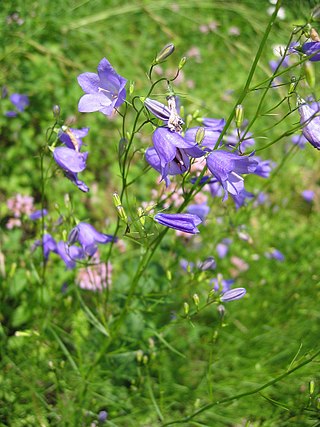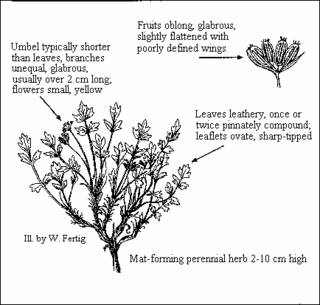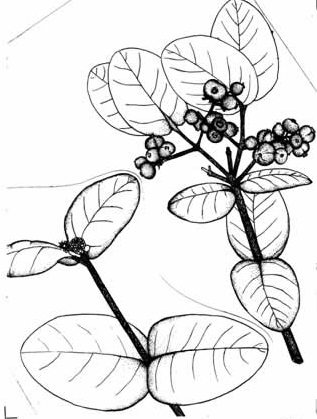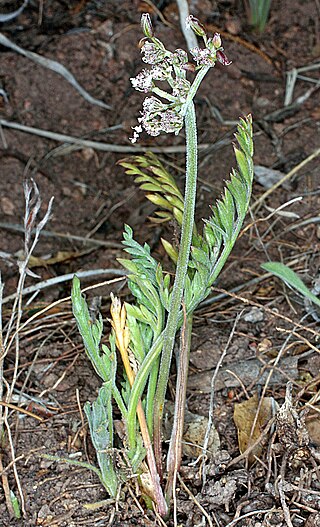
Campanula rotundifolia, the harebell, Scottish bluebell, or bluebell of Scotland, is a species of flowering plant in the bellflower family Campanulaceae. This herbaceous perennial is found throughout the temperate regions of the northern hemisphere. In Scotland, it is often known simply as bluebell. It is the floral emblem of Sweden where it is known as small bluebell. It produces its violet-blue, bell-shaped flowers in late summer and autumn.

Echinocactus is a genus of cacti in the subfamily Cactoideae. The generic name derives from the Ancient Greek εχινος (echinos), meaning "spiny," and cactus. It and Ferocactus are the two genera of barrel cactus. Members of the genus usually have heavy spination and relatively small flowers. The fruits are copiously woolly, and this is one major distinction between Echinocactus and Ferocactus. Propagation is by seed.
Vesper multinervatus, synonym Cymopterus multinervatus, is a species of flowering plant in the carrot family Apiaceae, known by the common name purplenerve springparsley. It is a perennial herb native to the southwestern United States, including the desert regions. It is stemless, producing leaves and inflorescence at ground level from a taproot. The leaves are erect on petioles of a few centimeters in length, with a fleshy blade dissected into waxy multilobed leaflets. The inflorescence arises on a stout purple or greenish peduncle up to about 14 centimeters tall. At the top is a rounded cluster of purple flowers sheathed in purple-veined bracts.

Tiarella cordifolia, the heart-leaved foamflower, is a species of flowering plant in the family Saxifragaceae. The specific name cordifolia means "with heart-shaped leaves", a characteristic shared by all taxa of Tiarella in eastern North America. It is also referred to as Allegheny foamflower, false miterwort, and coolwort.

Aletes has been regarded a genus of flowering plants in the family Apiaceae, all of which are endemic to North America. As of December 2022, Plants of the World Online regarded Aletes as a synonym of Cymopterus, while GRIN Taxonomy regarded it as a possible synonym of that genus.

Conioselinum is a genus of flowering plant in the family Apiaceae, native to Eurasia and North America. Its species are erect perennial plants with deeply toothed compound leaves and umbels of white flowers. Plants of this genus are known commonly as hemlock-parsley.

Cymopterus is a genus of perennial plants in the family Apiaceae native to western North America. They are commonly known as the spring parsleys. They are mostly stemless, taprooted perennial herbs with leaves at ground level and flowering scapes bearing yellow, white, or purple flowers.

Myrcia sintenisiana is a species of flowering plant in the family Myrtaceae. It is endemic to Puerto Rico, where it is limited to the Luquillo Mountains. It occurs in El Yunque National Forest in dwarf forest habitat on wet mountain ridges. Its common name is beruquillo.

Lomatium donnellii is a perennial herb of the family Apiaceae, in the Western United States.
Acmispon argyraeus, synonym Lotus argyraeus, is a species of legume native to California and northwest Mexico. It is known by the common name canyon bird's-foot trefoil. It occurs in dry mountain habitat. It is a perennial herb lined with leaves each made up of a few oval leaflike leaflets about 1 cm long. Most of the plant is silky-hairy in texture. The inflorescence holds one to three pinkish-yellow flowers roughly 1 cm long. The fruit is a dehiscent legume pod up to 2.5 cm long.
Lomatium fusiformis, synonym Orogenia fusiformis, is a species of flowering plant in the carrot family. It is known by the common name California Indian potato. It is native to the western United States from California to Montana, where it grows in high mountains in rocky, gravelly habitat.
Rhinotropis heterorhyncha, synonym Polygala heterorhyncha, is a species of flowering plant in the milkwort family known by the common names beaked spiny polygala and notch-beaked milkwort. It is native to southern Nevada and it is known from a few occurrences just over the border in the Funeral Mountains of California above Death Valley. It is a resident of desert scrub habitat. This desert plant is a perennial herb or small shrub growing in small clumpy mats. The thin, branching, thorny-tipped stems are somewhat waxy in texture and sometimes slightly hairy. They are lined sparsely with small oval, dull-pointed leaves. The inflorescence bears a few flowers, each with a winglike pair of bright pink sepals and a yellow-tipped central petal. The fruit is a vein-streaked capsule.

Castilleja septentrionalis is a species of Indian paintbrush known by several common names, including northern paintbrush, sulfur paintbrush, and pale painted cup. There is taxonomic disagreement as to if it is one species widely distributed in mountain and alpine environments of North America or if there is a second species, Castilleja sulphurea, in the Rocky Mountains.

Astragalus limnocharis var. montii, synonym Astragalus montii, is a rare variety of flowering plant in the legume family. It is known by the common name Monti's milkvetch. It is endemic to Utah in the United States, where there are only three known populations. Under the synonym A. montii, it is a federally listed threatened species of the United States.

Cymopterus humilis, synonym Oreoxis humilis, is a rare species of flowering plant in the carrot family known by the common name Rocky Mountain alpineparsley. It is endemic to Colorado in the United States, where it is known only from the vicinity of Pikes Peak. There are three occurrences, for a total population of about 4240 individuals.

Neoparrya is a monotypic genus of flowering plant in the carrot family Apiaceae. Its only species is Neoparrya lithophila, also known by the common names Bill's neoparrya and rock-loving aletes. It is native to Colorado and New Mexico.

Lomatium plummerae is a formerly recognized species of plant in the carrot family (Apiaceae). When recognized, it was subdivided into a number of subspecies and varieties. As of August 2021, Plants of the World Online considers the species itself and the variety helleri to be synonyms of Lomatium donnellii, and the varieties austiniae and sonnei as synonyms of Lomatium austiniae, whereas the Jepson eFlora considers the species and the varieties austiniae and sonnei to be synonyms of Lomatium donnellii.

Claytonia rosea, commonly called Rocky Mountain spring beauty, western springbeauty or Madrean springbeauty, is a diminutive spring blooming ephemeral plant with pale pink to magenta flowers. It grows a small round tuberous root and it one of the earliest wildflowers of spring in its range. It is found in dry meadows in forests of ponderosa and Chihuahuan pines, and moist ledges of mountain slopes of the Beaver Dam Mountains of Utah, Colorado Front Range, and Sierra Madre Occidental, south and east to the Sierra Maderas del Carmen of Coahuila.
Drymocallis fissa, the bigflower cinquefoil, also known as the leafy cinquefoil, leafy drymocallis, or wood beauty, is a small plant also sometimes classified as Potentilla fissa. It is a herbaceous plant with a thick taproot known for its moderately hairy leaves, redish leaf stems, and relatively large yellow flowers. It is native to foothills and lower mountains the Rocky Mountain region in the western United States.

Lomatium orientale, commonly known as salt-and-pepper, eastern cous, eastern desert-parsley, eastern lomatium, white-flowered desert-parsley, oriental desert parsley or Northern Idaho biscuitroot, is a small spring blooming ephemeral plant. It grows in open habitats from the plains to foothills in western North America. It is known as one of the earliest blooming native flowers in its habitat. The species name, "orientale", is botanical Latin meaning "eastern".















